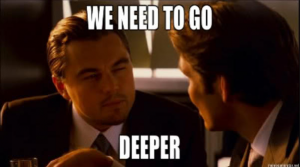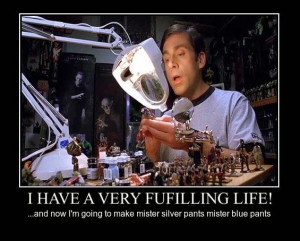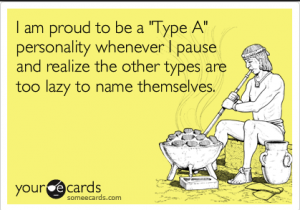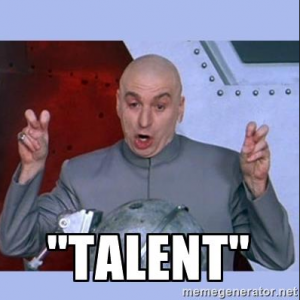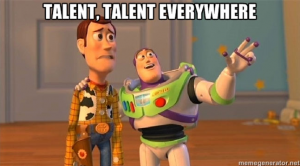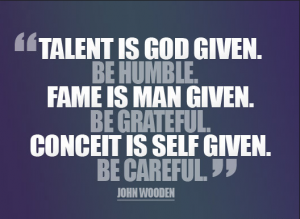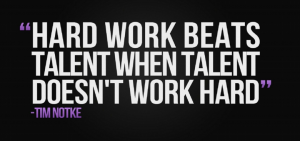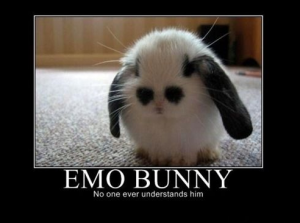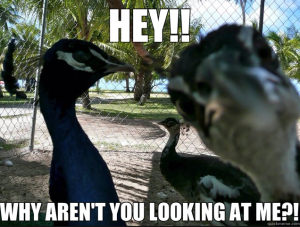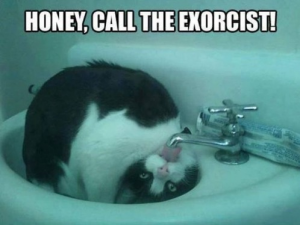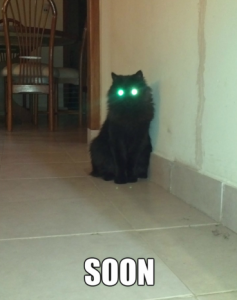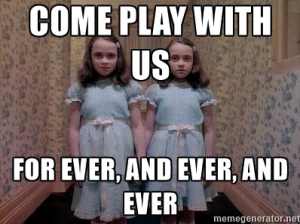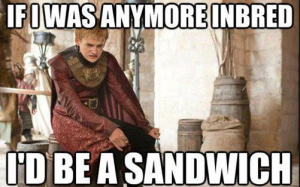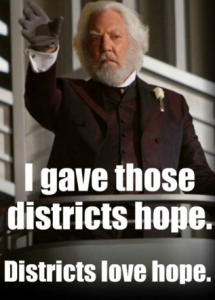Kristen Lamb's Blog, page 32
April 12, 2017
Deep POV Part 2—How to Immerse the Reader in Story
 Image via Flickr Creative Commons courtesy of FromSandToGlass
Image via Flickr Creative Commons courtesy of FromSandToGlassSo last time we introduced Deep POV. What is it and why do readers love it? Well, as I touched on last time, I think readers love it because it’s just clean, tight writing that pulls them into the story. I also think like all other POVs that have evolved in tandem with social changes, deep POV is a consequence of our world. We are a reality TV generation and we love that intimacy.
But after noodling it a couple days, I thought of yet another reason it behooves writers to learn deep POV. I think the reason readers love it is it hooks them. We live in a world chock full of millions of tiny distractions, which has made all of us more than a little ADD. A hundred years ago, readers weren’t distracted by emotionally distancing words.
They were an easier fish to catch, so to speak.
I think these days, writers really have a challenge. We are already competing with countless distractions, so why add more into our work? We need to hook early, hook hard and drag that reader under before he swims away.
Today is the HOW TO DO THIS.
To accomplish “deep POV” yes, there are style changes we can make, like removing as many tags as we can and ditching extraneous sensing and thinking words. But deep POV is more than just tight writing, it’s also strongly tethered to characterization. Good characterization.
It is essential to know our cast if we hope to successfully write “deep POV.”
KNOW Your Cast
There are all kinds of ways to get to know our characters. I often write detailed character backgrounds before starting a story so it doesn’t become a fish head.
Why we need to know our characters is that deep POV is a reflection of the inner self, how that character sees the world, responds, evades, processes, etc. It is also a reflection of personal history and relationship dynamics. It is his/her PARADIGM.
*cue brain cramp* *hands paper bag*
It’s okay. Breathe. We’re going to unpack this.
Reflection of the Character
 Image via Flickr Creative Commons, courtesy of DualD Flip Flop
Image via Flickr Creative Commons, courtesy of DualD Flip FlopBack when I ran a weekly workshop, I had writers do a little exercise to help them learn POV and also strengthen character-building skills. I gave this scenario:
We have a family of four—Mom, Dad, a grandparent (either gender) and a teen (either gender) who has spent a year saving for a family vacation. On the way to their destination, the vehicle breaks down. What happens and tell it from the perspective of EACH family member.
Every week, writers showed with the perspective of one of the four. We had ASTONISHING creativity.
Who These Characters ARE Changes the Story AND Deep POV
When we layer in some background, the characters (and consequently the story, problems and conflict) all change drastically.
What if dad is finally home from his forth tour in Afghanistan and has terrible PTSD?
What if Mom is a closet alcoholic?
What if the teen is recently in remission from Leukemia?
What if Grandma is a tireless flirt who’s antics got her turned into a vampire and the family can’t understand why Granny wants to travel only at night?
What if the teen is an asthmatic and forgot his inhaler?
What if Granddad has early on-set Alzheimer’s?
What if the teen has been recruited for a mandatory deep space mission by the New Earth government and will never see the family again?
What if the teen was adopted and the purpose for the trip was to meet the child’s birth mother? How would this impact the emotions of those in the vehicle?
What if there used to be TWO children and one had died in an accident a year previously?
Do you see how by changing WHO these people are, this cannot HELP but affect everything else?
If Dad has PTSD, he might jump at every lump of roadkill because that’s how insurgents hide IEDs. If the family is stranded and Mom can’t get to a liquor stash, she might start getting belligerent or, left too long, start going through DTs. What would an addict notice? Likely nothing beyond how to get a fix.
While a kid in remission with a new lease on life might enjoy being broken down in the middle of nowhere (appreciating the little things in life) the addict would be hysterical.
All of this will impact Deep POV because we are in the HEAD and EMOTIONS of the character.
Let’s pick on Mom for an illustration. I’m riffing this, so the writing is just an illustration. Just roll with it.
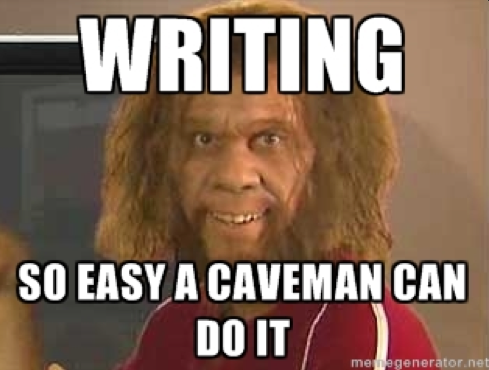 Geiko Caveman.
Geiko Caveman.Kidding! Lighten up. You seem tense.
Example One:
Fifi clutched the baby picture, the one she’d carried everywhere for fifteen years. She hated she was happy the old van had finally given out. Her husband stared, bewildered at the smoking engine. Other than car trouble, he seemed fine. Fine. How can he be fine?
She glanced back at her daughter, the living reflection her of all her dreams and failures. She’d wanted a baby more than life. Every night on a freezing floor. One miscarriage after another and then came a tiny bundle of everything she’d ever longed for.
That woman hadn’t wanted her. That woman had abandoned her. That woman was Gretchen’s real mother and now Gretchen wanted to meet her. Real mother, like hell. And I’m a real astronaut.
How had she failed? If she’d been a good mother, Gretchen would have forgotten that woman and they wouldn’t be here.
“You okay?” Her daughter bent between the seats and kissed her cheek. “You said this was okay, that we could do this. You’re sure, right?” A wary smile revealed new braces, the braces Fifi paid for with money she’d saved for a new van.
“I’m fine, Honey.” She crumpled the baby picture and opened the van door. She needed air.
***
Example Two:
Fifi clutched the baby picture, the one her daughter had given her a week ago for Mother’s Day when they picked her up from rehab. Ninety days clean. At least that was the lie she’d packed along with her swimsuit and the hairspray can with the secret compartment and the only pills they hadn’t found.
The pills that were now gone.
They should have already been at the resort, the one staffed with eager friends willing to help her out. Friends with first names only who took cash and asked no questions.
Fifi scratched at her arms. Millions of insects boiled beneath her skin, invaded her nerve endings and chewed them to bleeding bits. Pain like lightning struck her spine, the section crushed then reconstructed. Pain like lightning spidered her brain, frying her thoughts. She glanced again at the baby picture, then at the fine young woman in back. Her daughter Gretchen.
What am I doing?
Maybe she would be okay. Maybe she hadn’t had enough pills to completely undo her. Maybe she could ride this out. And maybe I’m the Queen of England.
Gretchen bent between the seats and kissed her on the cheek. “I love you, Mom. You okay?”
Tears clotted her throat. She nodded. “Yes, I’m fine, Honey.”
“You mean it?”
She hesitated then smiled. “Yes. Yes I do.”
She tucked the baby picture in her shirt pocket, close to her heart and opened the van door. She needed air. She also needed to change their plans. Visit somewhere with no friends. With no one who took cash.
Do you see how changing WHO Fifi is changes everything? Everything she is sensing, feeling, thinking. Being in the emotions of a heartbroken mother who feels betrayed is a very different experience from being in the head of a sympathetic addict who’s struggling to get clean and stay clean.
***
Both women are impacted by the daughter. One Fifi is hurt by the daughter, the other Fifi finds hope in the daughter. Both women are conflicted. One is tormented with feelings of failure and betrayal and the other is tormented by failure, but very real physical problems of addiction that impact the story.
Deep POV has thrust us into the head and emotions of both women. We feel what they feel. The author is invisible because there are no tags. The sensations are raw and visceral because we have gotten rid of the coaching words.
Instead of:
Fifi felt millions of insects boiling beneath her skin….
We get right to it.
Millions of insects boiled beneath her skin…
The sensation is CLOSER. There is no psychic distance. She isn’t thinking she is going to lose it. She isn’t wondering if she can keep it together. She is experiencing everything real-time and up-close.
Instead of:
Fifi thought, What am I doing?
She just does. We KNOW Fifi is thinking because we are camped in her head.
Deep POV is Akin To Method Acting
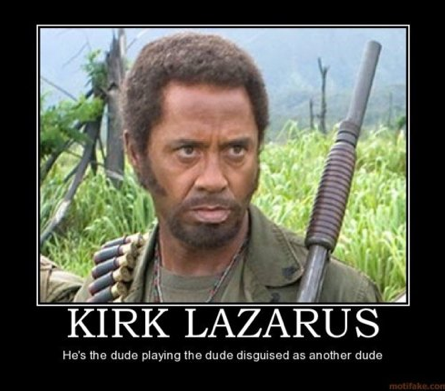 Couldn’t resist. I LOVE “Tropic Thunder”!
Couldn’t resist. I LOVE “Tropic Thunder”!When we know our characters, who they are, how they came to be, the formative experiences, what they want from life, etc. we can then crawl in that skin and become that person. By us becoming that character, we then have the power to transport our reader into the skins we have fashioned.
I hope this helps you guys understand the magical, mystical deep POV and now you’re all excited about writing stronger characters. What are your thoughts?
Before we go, check out the new classes below (including a two-week workshop on Deep POV by powerhouse editor Lisa Hall-Wilson). W.A.N.A. is also offering two NEW classes for romance authors, one on how to write shifters and the other on how to write great historical romance without needing a PhD in History.
I also have a SUPER AWESOME DEAL to help you whip that WIP into fighting form! I put together a Book Bootcamp (3 craft classes—6+ hours of instruction with MOI—for $99 & RECORDINGS included in the purchase price) as well at a Book Bootcamp GOLD (also 3 craft classes for the price of two PLUS three hours with ME one-on-one plotting your novel OR repairing the plot for your novel). So make sure to check those out below along with all kinds of new classes!
Make sure you check out the newsletter class with Jack Patterson. He’s sold almost a quarter million books, so probably someone to listen to. Just sayin’…
What are your thoughts?
I LOVE hearing from you guys!
****The site is new, and I am sorry you have to enter your information all over again to comment, but I am still working out the kinks. Also your comment won’t appear until I approve it, so don’t fret if it doesn’t appear right away.
Also know I love suggestions! After almost 1,100 blog posts? I dig inspiration. So what would you like me to blog about?
Talk to me!
And to prove it and show my love, for the month of APRIL, everyone who leaves a comment I will put your name in a hat. If you comment and link back to my blog on your blog, you get your name in the hat twice. What do you win? The unvarnished truth from yours truly.
I will pick a winner once a month and it will be a critique of the first 20 pages of your novel, or your query letter, or your synopsis (5 pages or less).
SIGN UP NOW FOR UPCOMING CLASSES!!!
Remember that ALL CLASSES come with a FREE RECORDING so you can listen over and over. So even if you can’t make it in person? No excuses! All you need is an internet connection!
Be a Better Hooker (How to Write a Compelling Newsletter)
April 29th $45
In this class, learn how to compose a newsletter that is entertaining and compelling—and all without stealing most of your writing time. Learn how to get your hooks in your readers and keep them until the end.
With a mailing list of over 15K subscribers, mystery/thriller author Jack Patterson will share some of his tips that will spice up your newsletter and get your subscribers opening it up every time you send one out.
BUNDLE DEALS!!!
Book Bootcamp $99 ($130 VALUE)
Book Bootcamp GOLD $269 ($430 VALUE) This includes the log-line class, antagonist class, the character class AND a three-hour time slot working personally with ME. We will either plot your idea or, if your novel isn’t working? Fix it! Appointments are scheduled by email. Consults done by phone or in virtual classroom.
Individual Classes with MOI!!!
Pitch Perfect—How to Write a Query Letter and Synopsis that SELLS! $45 April 13th, 2017
Blogging for Authors $50 April 27th, 2017
Your Story in a Sentence—Crafting Your Log-line $35 May 4th, 2017
Bullies & Baddies—Understanding the Antagonist $50/$200 (Gold) May11th, 2017
The Art of Character $45 May 18th, 2017
NEW CLASSES/INSTRUCTORS!!!
Growing an Organic Platform on Facebook $40 May 6th, 2017 Lisa Hall-Wilson is BACK! She is an expert on Facebook so check out her class!
Method Acting for Writers: How to Write in Deep POV $85 for this TWO WEEK intensive workshop with editor and writing instructor Lisa Hall Wilson.
Shift Your Shifter Romance into HIGH Gear $35 May 19th with powerhouse editor Cait Reynolds.
Researching for Historical Romance (How to NOT Lost 6 Hours of Your Life on Pinterest) $35 May 20th
For those who need help building a platform and keeping it SIMPLE, pick up a copy of my latest social media/branding book Rise of the Machines—Human Authors in a Digital World on AMAZON, iBooks, or Nook.
April 10, 2017
DEEP POV—What is It? Why Do Readers LOVE It?
So maybe you’re bee-bopping along on the interwebs, clicking on blogs, checking out writing resources when you see it float across your tweet deck. Or perhaps you’re at a writing conference looking all intellectual and stuff, and in the conversations this phrase deep POV keeps floating past. Deep POV. Deep POV. You keep hearing it, seeing it…
And, if you are anything like me, you don’t want to look like an idiot so you don’t ask that question burning inside you.
Um, what the heck is deep POV?
***Note to self. Google Deep POV at home under cover of darkness.
So what the heck is it and why do we need some?
If you are a writer who has a goal of selling books it is wise to remember that audiences are not static. They change. Their tastes change with the times and we need to understand what is “trending” if we want to connect and entertain. Many new writers look to the classics for inspiration and there isn’t anything per se wrong with that, but we must reinvent the classics, not regurgitate them.
Even if you look at the fashion trends, sure some styles “come back around” but they are not exact replicas of the past. They are a modernized version. But keep in mind that some fashion styles never come back. They’ve outlived their usefulness and belong in the past. Same with fiction.
Story trends and fashions change along with the audience. For instance, Moby Dick spends an excruciatingly long time talking about whales, namely because the audience of the time probably had never seen one and never would. If we did this today? Sure, feel free to walk around in a literary gold-plated cod piece, but er…
Yes, awkward.
Epics were also very popular. Follow a character from the womb until death. FANTASTIC STUFF! Why? Because no one had HBO, Pinterest or Angry Birds. Books were a rare indulgence usually reserved for a handful of literate folks with the money or connections to get their hands on…a book.
Also, since writers were paid by the word, their works were padded more than a freshman term paper. Their motto? No modifier left behind. These days? We have to write leaner, meaner, faster and cleaner.
We’ve talked about POV before, and which one might be the best for your story. I can’t choose for any of you, but before we talk about deep POV, I want to mention that POV is also affected by audience and I believe is a direct reflection of how connected we are as a society.
You guys may or may not know that POV has changed along with communication and connectedness. Waaaaay back in the day, omniscient with a god-like narrator was all the rage. But people didn’t travel at all. Most humans lived and died in the place they were born and in isolation from other communities.
With the early epics, we often had a narrator who was separate from the events.
Dear Reader, come with me for a tale of AWESOME…
Later, after the Dark Ages, people got out more, traveled more, etc. We see the narrator merging into just general god-like presence. Then, after the printing press was invented, more and more people were reading and a lot of monks were out of a job and went off to start the first microbreweries.
Don’t argue. It’s history 
April 7, 2017
How to Make ALL Ads, Marketing & Newsletters Work BETTER
 Image courtesy of Flickr Creative Commons, courtesy of Enrico Petrarolo
Image courtesy of Flickr Creative Commons, courtesy of Enrico PetraroloAll right, so Monday we talked about The Single Best Way to Become a Mega-Author, which is—in a nutshell—write a LOT of (good) books. They key is being prolific and this applies no matter what type of publishing we choose. If you go browse a local used bookstore (which is almost pure legacy press) trust me, you will see the same names over and over and over and over.
Readers have always had a tendency to be parochial when it comes to their reading choices. We tend to find a writer we like and stick like glue until we have exhausted their titles. Why? Because reading a book is a HUGE investment of our most precious commodity—TIME.
We don’t want to spend an average of 12-15 hours of undivided attention with just anyone. We also are in an age where we are inundated with choices, which tends to short circuit the brain cells.
But many writers want the magic for selling a lot of books and frankly, that doesn’t exist. Huge success with such a subjective commodity is still, to an extent, trying to capture lighting in a bottle.
Ah, but we can improve our odds. First with, as mentioned, multiple good books. Then there is social media and building a platform.
Our Foundation Matters
 Image via Flickr Creative Commons courtesy of Carlpenergy
Image via Flickr Creative Commons courtesy of CarlpenergyThe foundation for all goods and services (brands) is the relationship. Nothing sells without establishing, building and improving the relationship. Relationships take time, effort, energy, prayer and patience. They can take years to build and moments to destroy, so we must always value that relationship.
This is ALL commodities from restaurants to grocery stores to soap to shoes to electronics. Samsung was and is a strong brand, but how much damage did the Galaxy 7’s exploding battery do? Consumers no longer could trust the product so they lost faith in the brand.
The same goes for authors. One of the many reasons I love for authors to have a blog is that it is an excellent way to create a relationship and build trust. You guys come to this blog because you trust that you will be educated, enlightened and entertained. Over 1100 blogs and still going and still improving. You don’t come here and get frustrated with a sea of typos, poor grammar, etc.
I’ve worked hard to create a relationship. I give first. Yes I mention classes and my books, but no one is required to buy. But because I give first and often, no one is offended that I list a class because I am not just taking, taking, taking.
Same with social media. Those who follow me on Facebook know what to expect. Most of the time, I share funny memes or engage people in conversation. I comment on their stuff, “Nice dress!” “Love the new profile pic!” Small acts every day. Again giving.
So when I finally DO post something about a class or a book or a conference I already have a foundation. I have a base of people who know me and who hopefully enjoy my company and so when I “advertise” the response is more positive because, out of everything I post, the “taking part” is far less than the giving. Instead of….
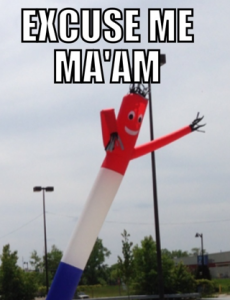 AHHHHHHH!
AHHHHHHH!Yet how many writers don’t want to be on Facebook, they don’t like Twitter and they only join to blast people with ads and free books and giveaways. They only get on their author page to talk about themselves, their signing, their event, their book. They don’t take five minutes to care about anyone else, but we’re all supposed to drop everything to serve them?
They don’t even give their time. Rather they cheat with automation, but they want MY time?
Sure. Right on that,
A Little Goes a LONG Way
The shocking thing is that we really don’t need to give all that much for it to matter.
For instance, if someone emails me with a question of a favor, and I recognize that name from comments on my blog, I will often move heaven and earth to help, and often for free. Yet, I can’t count the number of people who email me with a copy of their book for me to review or edit and they’ve never taken two seconds to say so much as hello.
So I am supposed to part with my money and 15 hours of time I don’t have?
Same on Facebook. They IM me to vote for their book or buy their book or for me to promote their book and they have never taken two seconds to so much as comment on a post, say hello or talk to me.
These people are TAKERS.
But the people who always post comments or share or promote me? Again, it is ridiculous the hoops I will jump through to help a giver.
Newsletters are the same deal. My email is absolutely flooded with lazy writers who paid some company to somehow get my email. 99% of newsletters instantly go in the trash, and in a way those newsletters offend me. This writer couldn’t take two minutes to talk to me to even see if I READ that genre? Oh, but they’re happy to take.
Ain’t nobody got time for that.
This is one of the reasons my book Rise of the Machines focuses so much on the day to day building of the brand and platform. Writers always assume I spend vast amounts of time on social media.
Nope.
Aside from the blogs? I pop in randomly throughout the day for a few minutes and that’s it.
If we don’t have those small everyday actions that accumulate into a relationship of depth, then it is a craps shoot. Additionally it is a race to the bottom of who can give away the most stuff and for the cheapest or FREE. That is the price of wanting the fruits without the roots and perks without the works.
Marketing & Advertising
 Image via Flickr Creative Commons, courtesy of Faye
Image via Flickr Creative Commons, courtesy of FayeAll marketing and advertising works better with an established relationship. Why are we more inclined to actually use a Starbuck’s coupon? Because Starbucks has created a relationship with its product and service. Their coupon is far more likely to be used than Joe’s Joe Shack because we don’t know Joe from Adam.
Unless Joe offers us a coupon so ridiculously cheap we cannot ignore it? It’s far more likely to go in the trash or be forgotten. And even if Joe succeeds in getting us in the door, he is still starting from ground zero building our trust. If his coffee sucks? It won’t matter if he gives an even steeper discount the next time.
In the beginning almost all writers are like Joe’s. Legacy gets a bit of a pass but not much. Most readers don’t buy books by publishing house. In fact they might be hard-pressed to name one of the Big 5. But, if a book is on shelves at B&N, that book (author) is then using B&N’s relationship (brand) to kindle its own.
But since most readers aren’t going to B&N? As I said, a small pass.
Even in a bookstore the writers we know will almost leap off the shelves at us. I can’t count the number of times I bought books I hadn’t planned on buying because I knew the author from Facebook, Twitter or their blog (the GIVERS).
The rest of us (indies in particular) are going to have to do a lot of giving to establish the rapport, proving we are a good investment of TIME.
I did this with my blog. Y’all know my style, my voice and can trust I produce content you enjoy. Not a huge stretch to imagine my books probably would be at least as well written as my blog. So when I have a book for sale, I’m building off an established relationship (brand).
Additionally, if I told you guys that one day next week, I was giving Rise of the Machines away for free, I guarantee more people would grab a copy of ROM than if I just popped out of the blue and ambushed you with free books.
Or if I said ROM was on sale for $2.99 I would have far better ROI than some stranger foisting a cheap book at you.
See, any marketing or ads or giveaways or sales now will work better because I’m not just assaulting you from the ether with free and or cheap books. That giveaway or freebie is just more value added to something already valuable to you.
There are a lot of wonderful book marketing people out there, but the stronger that base platform and brand, the more they have to work with. They’re marketers not magicians.
Ads are a failure if no one clicks it and no one buys. I don’t care if we get a newsletter list of a million. If no one opens it and no one acts and buys the book, again it is a failure.
How we improve those odds is first creating the relationship on-line with our blog or social media. Then eventually the books. If they trust us in a blog and we impress them with a book? We are golden so long as we keep nurturing that relationship. Ads and marketing work better.
But, skip the foundation? Skip the relationship building? Skip the day to day? It is a long, unpleasant and all too often unsuccessful battle that, in the end, will cost far more time, effort and money than if we just did the little stuff day in and day out.
For more help with that, grab a copy of my book and check out my blogging and newsletter class (listed below) 
April 5, 2017
Choose Your Pain—Hobbyist vs. Professional Author
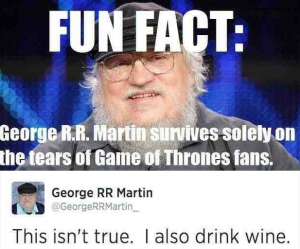 You know you’re jealous, LOL.
You know you’re jealous, LOL.This blog focuses mainly on those writers who desire to make a living writing fiction. Last post, The Single Best Way to Become a Mega-Author garnered an interesting comment, though not an unusual one.
Anytime I write one of my posts regarding success or sales or being a best-seller, inevitably I get the “What about just enjoying writing?” comment.
And the observation is a valid one, though one I don’t always think about because, to me, writing never feels like work, though in truth, it is REALLY hard work. I work longer and harder now than I ever did in my years in sales.
It just never seems that way.
Hobbyist Versus Pro
This blog, at least when we are referring to craft, applies to anyone who wants to write good stories. The hobbyist, however, is different. This person is not creating a commodity.
The work produced is solely for the personal enjoyment of the creator and if it fulfills that purpose, it really doesn’t matter if there is no plot, 42 different POVs and so much purple prose one might choke on all the metaphors.
Yet, the second we want to command time and money from another person to read our work, our job description changes. Sure at home we might have a habit of drowning a hamburger in weird condiments, but if we were serving that to others (I.e. our restaurant)? We’d need to be mindful that maybe other people don’t want Nutella on a burger (yes, people eat that, I googled it).
Additionally someone who whips off fan fiction or stories in their free time is not beholden to the business end of what we do. They don’t need to know about branding or social media or marketing or newsletters. Since this blog caters to those who wish to make money at this? All of that is vital.
Go Big or GO HOME
Now I will admit that I have big, okay, mega dreams. I am not Type A, rather Type A+ because I did the extra credit assignments.
Slackers.
In my mind if I shoot for the stars I might just hit the moon. I always aim big because I imagine that if I adopt the habits of a mega-author that can only turn out well. This means I read tons of books, I study, I inhale craft books and blogs.
I study other authors and I write and write and write. I write every day. I adopt good habits and self-discipline and in some way—even if I fall short of every being Nora Roberts—it’s still a pretty solid formula to do well at my craft and business.
Additionally, notice how much of my hard work incorporates things I already enjoy (ergo WHY I left sales and became a writer). As a writer, I should enjoy reading and watching movies and studying story. I should enjoy writing and revising and getting better and if I don’t? Houston, we have a problem.
Yet, your dreams are your dreams and not everyone wants to break records or re-imagine entire genres. Not everyone has the want or ability to write four books a year.
So…don’t 
April 3, 2017
The Single Best Way to Become a Mega-Author
 Image via Flickr Creative Commons sourtesy of German Poo-Camano
Image via Flickr Creative Commons sourtesy of German Poo-CamanoA lot has changed in the digital age of publishing and, with gatekeepers no longer in sole control over who is published, we’ve seen a rise of the virtual Wild West. Lots of would-be writers striking out in search of publishing gold. And as happens with any kind of “gold rush” there are always those who will capitalize (or even prey) on the dreams of the neophyte.
The goal of this blog has always been to be a guiding light in a dark and uncharted world. Though we’ve come a long way in the past few years, there is still so much left to explore. Yet? Fads abound. The reason these fads continue to rook in writers is they did work for someone somewhere at some time.
It’s sort of like the lottery. If no one ever won the Power Ball, no one would buy tickets and yet lottery tickets are a lousy substitute for financial planning and savings.
Fads and gimmicks and algorithmic voodoo might work for some and might work short term, but the plain fact is that no amount of social media magic, no newsletter, no blog can launch us to mega-author status.
So What Works?
Today, for the sake of brevity, we are going to focus on the single most important factor for author success. We will talk about other things like newsletters and blogs and social media later.
The single best way to be successful is to be prolific. Write a lot of books. And, since we are in a paradigm with no gatekeepers, I will add a qualifier. We need to write a lot of GOOD books.
I get sample pages that are so bad I could weep…only to find out the writer already has three or four or ten books out. They are mystified as to why their social media isn’t working and why they aren’t selling any books. The answer is simple. It’s because the books are terrible.
So YES be prolific, but we must make sure we are writing good books and then better books.
Seriously….
Last week we were hit with a brutal line of storms and were without power most of the week (which was I was absent 
March 22, 2017
Do Some People Lack the Talent to be Authors?
After the last post, we got in a rather spirited discussion in the comments regarding talent. Lora, an editor, was relaying a common malaise many editors feel (I’ve felt it myself plenty of times), which posits the eternal question.
Are there just some people who simply lack the talent to be novelists?
Good question.
A huge problem is that far too many people believe that a “clever” idea and command of the English language is all that is required to become a novelist, yet that is not the case. We’ve witnessed this with the rise of self-publishing. There are simply a lot of really BAD books out there.
Lora challenged me to write a post that might serve as some kind of a litmus test for talent, but in truth? Such a list is beyond the scope of my abilities because I don’t know if such a checklist exists.
Sales certainly are no indicator of talent. There are plenty of brilliant books that don’t sell or sell poorly and there are other works that sell a gazillion copies and show us clearly how taste has at least fifty shades.
Some emerging writers possess all the technical skills, yet their writing is uninspired, utterly lacking in the je ne sais quoi required to elevate the writing from the mundane to the magical.
Their “stories” are flat and functional, much like a DMV building. Sure, it has the right walls and fire escapes and passes inspection, but it isn’t a place we’d want to sit down and get comfortable.
Other writers are completely lacking in the technical skills, yet even with their wobbly first tries, one can see a spark of genius there.
Does Talent Matter?
Stephen King talks about talent in Danse Macabre (and other places as well) and I really love his view on it. He says:
Talent is cheaper than table salt. What separates the talented individual from the successful one is a lot of hard work. ~Stephen King
I firmly believe that and we will get to that in a moment.
Yet, even though King is no huge fan of “talent” he does admit talent is necessary even if it isn’t quite the panacea people might imagine. He equates talent to a vein of gold in a mine. One has to do the hard work of digging for the ore, refining, etc. (the nasty work most people don’t want to do).
He says if you spend an hour and a half a day writing for ten years, at the end of ten years, you’ll be a pretty good writer. Just as if you spent an hour and a half a day digging, mining, and refining ore, you’d eventually have decent stockpile of gold.
Yet, spend ten years refining common earth? At the end of ten years all you’d have is common earth.
Sad to say that common earth writers do exist.
In my experience, I would have to say I have no good answer for how to spot a common earth writer. Most emerging writers who seem to completely lack talent actually lack something else.
Humility.
Remember at the beginning of this post, I mentioned that too many people believe this job is easy and that, in my estimation, this is the crux of the problem.
In the pre-digital paradigm, not everyone could be published. This meant that aspiring writers who failed to do the hard stuff—read prolifically, study, practice, take classes, go to conferences, get professional editing help when needed, etc.—languished in the slush pile.
One of two things happened.
Either the aspiring writer finally gave up after enough rejections OR he/she was forced to take a hard and critical look at the work and improve. Write more stories, and better stories. Creative crucibles were personal and private affairs.
The reason it used to be a really big deal to call oneself a “published author” was it was a title granted only to those who’d successfully endured the gauntlet and the title was the crown of olive leaves denoting the victor.
The writer had solved the labyrinth and emerged as author.
These days no such crown exists and we writers have been demoted to comparing rankings and royalty checks to discern “success” and if we are “good writers,” which can be demoralizing in itself. In the pre-digital paradigm, simply being published was met with awe from mere mortals because it represented a threshold few were ever able to cross. Even if we only sold a handful of books, we were still a success.
Now that “success” has been democratized? I’m not even sure the best writing is what makes the most money. In fact, I’m certain of it.
Pride Before the Fall
I get writing samples so bad I wonder if the writer has ever even read a book. It isn’t fiction, it’s self-indulgent navel-gazing. The characters sound like girls playing Barbie or a young boy fascinated on his personal holodeck. There is no understanding of POV, pacing, structure or even the essentials of good dialogue. I don’t have a novel, I have tropes mixed with cliches then slathered in purple prose.
****Hint: People don’t keep referring to one another by name when they talk in real life.
I can always tell the writers who won’t make it, and oddly it has really nothing to do with the writing.
Often I get a really nasty e-mail in reply that all their friends loved it and their writing group thought it was the best thing since kitten calendars. I’ve also gotten people who took my classes just to argue with me the entire time.
Then go blog about what an idiot I am.
It Really Isn’t All About the Writing
Yet? Some of the absolute worst writing I have ever encountered was not the end. Their creators went on to be successful and even damn fine authors. Why? Because they were teachable.
When I shredded their pages to the point one couldn’t even see the original text, they cried, then got over it and took my offer of help. They were willing to spend hours on the phone with me showing them how to kill all their little darlings. They read the craft books I recommended, took the classes I offered, did the exercises I assigned. They slaved and wrote and rewrote and then? Voila!
Sure, they sucked. But one day?
…they no longer sucked.
I had a winner of my first 20 pages back when I first ran the contest in 2011. Oh my GOD it was bad. But I offered help as I generally do. We spent hours on the phone and Kathy was struggling. She continued reading my blogs. She took my Hooked class….and got slayed again.
And again.
And yes, again.
Then something remarkable happened. She signed up for my Hooked class again last year. I didn’t see her name and just read pages and they were….brilliant. I didn’t want to stop. It was a REALLY excellent submission.
Then I saw the name and almost cried I was so proud.
Another emerging writer paid me for a full edit. The book was excellent to the midpoint then completely fell apart into a disaster. I explained how it went wrong and what needed fixing and how to fix it. Instead of insisting I was a moron with no taste? He listened. I just forwarded his final to a literary agent friend of mine. Two days after sending in his manuscript I got a breathless e-mail from the agent that she was simply stunned by his talent.
Was it talent? Really?
Every time I have run into what might be written off as a “common earth” writer I’ve seen a person who refused to grow. They brought pages every week for critique and despite help and suggestions? Never changed.
They refused to read books on craft because they didn’t want their writing to be “formulaic.” They didn’t read fiction in or even out of their genre because “NY only published crap.” And on and on and on. They just kept recycling the same dreadful writing and now that self-publishing has made it possible to skip gatekeepers?
These same writers greedily snatch up the title of “published author” but then gripe that their crappy book isn’t selling because they “don’t have the mega marketing budget of a NY published book.” In their minds, all that is lacking is the right marketing plan, ad campaign or newsletter list.
Back to the Mines
 Image via Flickr Creative Commons courtesy of James St. John
Image via Flickr Creative Commons courtesy of James St. JohnWhen it comes to varying levels of talent (or lack thereof) I think we need to return to the mines. Some mines are easy. Gold dust and small nuggets all scattered about. Very little effort required to get at the good stuff. We all want this kind of mine and yet it, too is imperfect. This “gold” also requires refining. Also, gold scattered on the ground is no clear indication of the size of the overall vein. Maybe this writer has ONE good book in her.
There are those of us who dig through layer after layer with only a dream. Some vague indicators of gold. If we just keep pressing, we will find it. It is there, just an SOB to get to.
Then there are those who go digging for gold and find something else entirely. They strike oil, massive veins of salt, or a giant artesian spring. Still valuable, just not in the way planned. Some writers begin writing fiction and find they are far better bloggers or they excel at non-fiction. Some discover they are crazy good editors (more skilled at the refining process).
And lastly, there is common earth which I believe exists. These folks are almost “tone deaf” when it comes to storytelling. No matter how teachable, how many classes, the writing will just never be there. They are the person who can never quite deliver a punchline. This type of writer exists for sure, but may not be as common as we imagine.
In the end, I have no litmus test for talent, but I have a pretty good indicator of success. Are we teachable? Are we striving to grow, to get better, to actively seek tough critics to make us grow? Do we have rhino-skin? Can we take constructive criticism?
Are we sticking with this long enough to grow that talent? Are we reading enough craft books or taking enough classes to develop discernment so we know constructive criticism from sniping BS? Are we being brave enough to ask the hard questions and ready to endure the answers? Are we making the most of the editors we hire? Or are we defending and arguing? Are we writing? Yes take classes and read but we also need practice. Are we getting enough?
Are we humble?
To me? THAT is what separates the amateur hack from the pro, NOT necessarily skill level.
What are your thoughts?
I LOVE hearing from you guys!
****The site is new, and I am sorry you have to enter your information all over again to comment, but I am still working out the kinks. Also your comment won’t appear until I approve it, so don’t fret if it doesn’t appear right away.
Also know I love suggestions! After almost 1,100 blog posts? I dig inspiration. So what would you like me to blog about?
Talk to me!
And to prove it and show my love, for the month of MARCH, everyone who leaves a comment I will put your name in a hat. If you comment and link back to my blog on your blog, you get your name in the hat twice. What do you win? The unvarnished truth from yours truly.
I will pick a winner once a month and it will be a critique of the first 20 pages of your novel, or your query letter, or your synopsis (5 pages or less).
February’s winner of the 20 page critique is Dominic Scezki. Congratulations! Please send your 5000 word WORD document (12 point, Times New Roman, one-inch borders, double-spaced) to kristen at wana intl.com.
SIGN UP NOW FOR UPCOMING CLASSES!!!
Remember that ALL CLASSES come with a FREE RECORDING so you can listen over and over. So even if you can’t make it in person? No excuses! All you need is an internet connection!
Individual Classes with MOI!
Blogging for Authors $50 March 30th, 2017
Plotting for Dummies $35 April 7th, 2017
Pitch Perfect—How to Write a Query Letter and Synopsis that SELLS! $45 April 13th, 2017
For those who need help building a platform and keeping it SIMPLE, pick up a copy of my latest social media/branding book Rise of the Machines—Human Authors in a Digital World on AMAZON, iBooks, or Nook.
March 20, 2017
The Novel That Isn’t a Novel—Do You Really Have a Story?
We have been doing a lot of talking about structure lately because if we as writers don’t grasp structure? We can never deliver story. Sometimes to see what a novel IS, it helps to look at what the novel is NOT. Thus today I am going to pick on the most common “novels” I see that really are not novels.
Hey, just because we wrote 85,000 words does not mean it is a story.
Sucks. I know.
The “My Book is About Inner Demons” Novel
Code for: I have no clue how to plot so I am just going to wax rhapsodic and hope if I use enough BS and glitter, it will work.
Nope.
It won’t.
Last time we talked about inner demons, but inner demons alone are not enough. Inner demons are NOT a story.
All dimensional characters have inner demons. The inner demon is not proprietary to the literary genre (literary folks just have more leeway to camp out there). Commercial fiction—the good stuff, not the throwaway stories—have characters who are dealing with very real internal struggles and who conquer them.
These internal struggles are tossed into a crucible by the plot problem that makes the demons outwardly manifest. The characters are not simply solving any problem, rather the perfect problem, the one that will force the existential crisis that prompts change.
When I see a lot of internal thinking and more thinking and even more thinZZZZZZZZZ…….
Where was I?
*wipes drool off keyboard*
Oh yes, thinking. This is not a story. This is self-indulgent tripe.
Most people are not self-aware. Yes, we all battle with inner demons every day, but even regular people hire therapists at a hundred bucks an hour to help give them some clarity.
Why humans gravitate to story is that we may never be able to name our own demons, let alone conquer them. But in the fictional world? Victory is possible.
In the beginning the inner demon is only going to be reflected in the world-view (paradigm) of the protagonist.
For instance, we may show a workaholic (a protagonist with a work or achievement-centered paradigm). If the character is thinking and musing, Gee, I really work too much. My kids are growing up without a father. My wife no longer loves me. This character is TOO self-aware.
In the beginning, the protagonist believes the paradigm works and will scream and yell and cry when we Author God, rip it away.
He believes success=love, fulfillment, etc.
It is only when the plot problem challenges this belief, shatters it, pulls the blankie away, that the character is forced to rethink the worldview and uncover the WHY. Why do I feel I am only lovable if I have a phat paycheck?
If the character gains this internal insight at the beginning of the story, there is no room for growth and it is cheating. The protagonist has been given insight without the existential crisis.
There is no golden fleece without the quest.
Part of the tension that will keep pages turning is that the reader, much like any therapist, probably spots the protagonist’s baggage from the get-go. The tension is wondering if the protagonist will reach awareness before it is too late.
Remember that the protagonist would fail if pitted against the antagonist (BBT) in Scene One. The protagonist must evolve into a hero in order to triumph.
The “I Have Two (or 3 or 4 or 5) Protagonists” Novel
Nope, we need to ask, WHOSE STORY IS IT?
Remember we have been talking about creating a CORE STORY PROBLEM for our novel. This means there is ONE protagonist. When I get manuscripts where a bunch of stuff is happening and there are three or four or five POVs and I have no clue who I am supposed to be rooting for?
This is a huge red flag there is no core story problem. ONE character has the role of the protagonist. The reason is structure.
In Act Three the protagonist evolves into a hero (presses on when all others would have turned back). He alone fights the BBT in Act Three. He is the one who undergoes the most change because he is the one to solve the core problem.
A slight deviation (exception) to this is what is called The Buddy Love Structure. A good example of this is Lord of the Rings and The Hobbits (Samwise and Frodo) are essentially grouped into one. Can they toss the Ring of Power into Mt. Doom?
Now, LOTR is a super complex plot. There are lot of other subplots and they are all essential for the success of Frodo and Samwise. Yet, in the end? It is their story—not Aragorn’s, not Gandalf’s.
It really is Frodo’s story (with Samwise being a super close supporting actor). Why? Aragorn, Gandalf, Merry & Pippin all have their own subplots which help get Frodo on Mt. Doom….but they don’t have the ring.
HE DOES.
One other way to know the story is about Hobbits? IT OPENS WITH THEM.
Structure dictates that the first character we meet (unless an obvious POV from a villain) is our protagonist. We are like baby chicks and we imprint on the first person we meet.
*imprints on Frodo Baggins*
As I mentioned a moment ago, exceptions would be introductions (whether in prologue or Chapter One) from the antagonist’s POV.
So if an unnamed killer is gleefully chopping up coeds to Madame Butterfly? We get that is probably NOT or protagonist/hero. Yet, I will see works like this where the book opens with the POV of a murderer and then I get the POV of a unit secretary, a wife and then, three chapters later, the detective.
NO.
If it is the detective who brings down The Aria Killer, we meet him off the bat. If we deviate from this, it confuses the reader.
***We also would need to ask why the hell all these other people have been given a POV.
Remember that with every POV we (the reader) need TIME to get attached. Additionally we as the reader, must also dedicate time into resolving that POV character’s problem and driving their arc. Like Blake Snyder said, “Everybody arcs!” But notice the word I keep using here.
TIME.
You have four or five or six POV characters? That is going to impact the overall length of the novel. Sure, Stephen King gets away with an 1100 page book, but can we?
And even in the case of two protagonists, one will be subordinate to the other.
Right now I am writing a Western Horror and I have the B story-line. The female bounty hunter plays a HUGE role in solving the plot crisis, yet it is my coauthor Cait’s character who will do the final face-off against the BBT. Also, just so you know, we have had to put this into a three-book series just because having multiple POV characters takes up space.
That whole time thing again.
The “But Lots of Bad Stuff Happens to Her” Novel
Bad situations are NOT a novel. Bad situations are not even conflict (but probably another post).
A novel involves a core story problem in need of resolution. Often what I will see are all these “pseudo-vignettes of bad things happening” with multiple POV characters and yet they are all roads that lead to nowhere.
This is not a novel, it is a mess.
Now, and we are getting to some advanced stuff here, there IS a vignette structure, but it is more than just unattached scenes of bad crap happening.
There is a method to that particular structure.
Often we see this structure when a GROUP forms the protagonist (Ya Ya Sisterhood, Sisterhood of the Traveling Pants, The Joy Luck Club), yet even then the GROUP will still have a point man (or gal). There will be an overall thematic point.
In The Joy Luck Club we have many vignette stories from all the members of the club, the mothers and daughters but, and this is a BIG BUT—two things make this different than The Novel that Is Not a Novel.
A true vignette will follow the rules of structure internally, meaning a protagonist presented with a problem who faces off and solves said problem by the climax of the story. It isn’t just scenes of passively reacting to bad stuff happening.
Additionally, the vignettes will group together to solve a bigger thematic problem.
Case in point. In The Joy Luck Club we open with Jing-Mei Woo who says this:
My father has asked me to be the fourth corner at the Joy Luck Club. I am to replace my mother, whose seat at the mah jong table has been empty since she died two months ago. My father thinks she was killed by her own thoughts.
The point of this entire novel is how the mothers left China trying to change, to set right the wrongs of their own mothers. Yet, though they changed geography, they’ve been unable to keep the same patterns from repeating in themselves and their daughters. The stories posit, Will they ever change? Can the chains of the past be broken?
And, though we get stories from many other POVs, it is bookended by Jing-Mei’s journey. Can she forgive her mother and get on that boat and meet her long-lost half-sisters or will she simply take her mother’s place and keep repeating the past?
The “But This is Really a Series” Novel
Often I will get “novels” where there either is not a core story problem, or there is kind of one….but the writer leaves off the book with a 1950s Batman ending. You know, protagonist is hanging off a cliff and all hope is lost, but the story is resolved if you read (buy) in the NEXT book….
Nope. That is cheating.
ONE CORE PROBLEM. If the book is a series, then there will be one core plot problem resolved by the entire series, but in each “entry” in the series, there is a core problem that must be solved to make it to the next leg of the adventure.
I get way too many writers who are fixated on having a series but they don’t even know yet how to write ONE book.
The “My Book is About Abuse” Novel
If I had a dollar for every new writer who wants to write about abuse…
And, in fairness, there is nothing entirely wrong with that…except that many emerging writers missed my earlier point that a bad situation is not a story.
Shock factor is NOT story.
Thus, the detailed account of abuse or rape or incest or whatever must be more than just the bad (or horrible) situation. A good writer must overlay whatever the topic is she/he is addressing onto the plot frame and that is where the character finds his/her power.
Thus, I recommend that if these touchy topics appeal to you, find books that do this well and pay attention to the story problem chosen to help the protagonist conquer the abuse.
Remember that often those abused don’t recognize they are being abused, so that paradigm in the beginning is often VERY skewed. The plot problem reveals the truth the character cannot bear to see and propels her to FACE it and face her tormentor and triumph.
Well there are probably dozens of other versions of Novels that Are NOT Novels, but this is a decent enough overview. And remember, there is a learning curve to all this. I wrote my own share of Novels that Really Were Not Novels when I was new, too.
What are your thoughts? Other than that you hate me and want to stab me in the face? Hey, I am offering my Plotting for Dummies Class, so that might help and breathe. We have ALL been there.
I LOVE hearing from you guys!
****The site is new, and I am sorry you have to enter your information all over again to comment, but I am still working out the kinks. Also your comment won’t appear until I approve it, so don’t fret if it doesn’t appear right away.
Also know I love suggestions! After almost 1,100 blog posts? I dig inspiration. So what would you like me to blog about?
Talk to me!
And to prove it and show my love, for the month of MARCH, everyone who leaves a comment I will put your name in a hat. If you comment and link back to my blog on your blog, you get your name in the hat twice. What do you win? The unvarnished truth from yours truly.
I will pick a winner once a month and it will be a critique of the first 20 pages of your novel, or your query letter, or your synopsis (5 pages or less).
February’s winner of the 20 page critique is Dominic Scezki. Congratulations! Please send your 5000 word WORD document (12 point, Times New Roman, one-inch borders, double-spaced) to kristen at wana intl.com.
SIGN UP NOW FOR UPCOMING CLASSES!!!
Remember that ALL CLASSES come with a FREE RECORDING so you can listen over and over. So even if you can’t make it in person? No excuses! All you need is an internet connection!
Individual Classes with MOI!
Blogging for Authors $50 March 30th, 2017
Plotting for Dummies $35 April 7th, 2017
Pitch Perfect—How to Write a Query Letter and Synopsis that SELLS! $45 April 13th, 2017
For those who need help building a platform and keeping it SIMPLE, pick up a copy of my latest social media/branding book Rise of the Machines—Human Authors in a Digital World on
March 17, 2017
How to Exorcise Inner Demons
We’ve been talking about the most critical flaw in most new manuscripts, and that is the lack of the CORE STORY PROBLEM. In order to make things simpler, I came up with the concept of the BBT (Big Boss Troublemaker) because the core antagonist is not always a villain. He/She/It merely has a goal that runs counter to what the protagonist wants. Without that core story problem in need of solving we don’t have a novel, we have Day of Our Lives.
Just bad situations mixed with melodrama and angst.
So we need to give our protagonist a problem and not just any problem, but the perfect problem and one that is seemingly insurmountable. Now, we as Author God know this is good for the protagonist, but our character will likely scream, cry and resist more than a toddler headed for nap time.
Yet, whenever I write about the BBT (core antagonist), inevitably I get this in the comments, which is perfectly fine and a legitimate question…
“Great article, Kristen. I have a question. What about novels with an internal conflict? Where the main character has to make a hard choice and all the conflicts with the “bad guys” in the story are really just manifestations of the MC’s own character flaws coming to light as she works out the solution? Is there a BBT in this situation?”
Short answer? YES!!!!
One of the toughest concepts to grasp in writing fiction is this notion of “inner demons.” In all my years working with writers and busting apart countless manuscripts, the single greatest weakness I’ve witnessed with writers is a failure to truly understand how to plot. And before anyone breaks out in hives that I am encouraging detailed outlines, I’m not.
But the problem with inner demons is they are…well…inner. This means that our job as writers is to draw the demons out so they can be destroyed. It’s kind of like The Exorcist, though green puke and spinning heads is all your call.
You might laugh but if you have ever seen any movie involving an exorcism, what is the general progression?
The victim starts acting weird. Not herself. At first it might be written off as depression or lack of sleep or not enough caffeine. Then as the demon gains a toehold, the outward symptoms become more pronounced. Maybe physical changes (growling voice, speaking in Latin). Priests intervene and stuff gets cray-cray but to defeat the demon, what has to happen?
The demon must give its NAME.
You know you watch far too many horror movies when you are no longer scared, but are yelling critique.
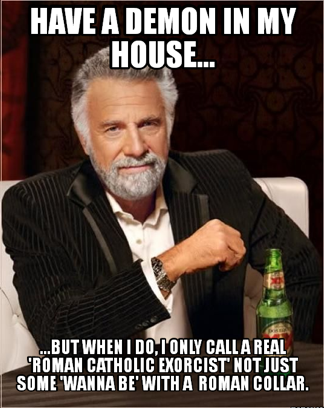
But the point of this I want to make clear is that the one thing these exorcism stories pretty much all have in common is the demon must be NAMED and manifest OUTWARDLY to be defeated.
Same in fiction.
Inner demons are tricky for a number of reasons we will talk about today. The trick is finding the plot problem that will drive the demon to the surface so it can be defeated.
Inner Demons are Inner
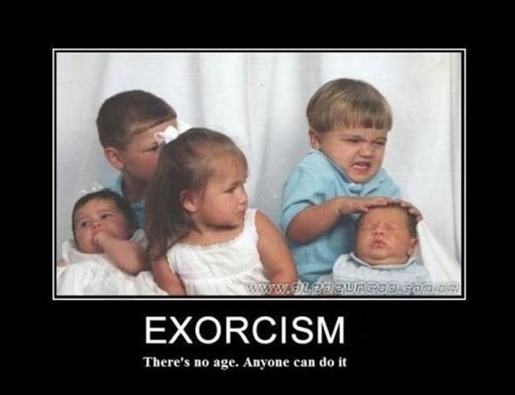
Yeah, I already mentioned that but this is kind of a big deal. Many new writers begin the novel with a character doing a lot of internalization and thinking and thinking and more thinking.
This is problematic for a number of reasons but the biggest is we (readers) just don’t care. We haven’t spent enough time to be vested in a stranger’s emotional baggage.
Do any of us like spending time in person with folks who do nothing but talk about their character flaws and problems? NO. So we are unlikely to want to pay to endure this too much in a book. Can we get there eventually? Sure.
Just like dating. I would hope by the time we dated someone a couple months we might know they haven’t talked to their father in three years and we would care about this problem. In the first fifteen minutes of a first date?
*backs away slowly* *slips barista a $20 to create a distraction to cover ex-fil*
Demons Hide in the Blind Spot

One key thing to remember about demons is they hide really really well. If they didn’t then shrinks would starve and be treated like writers.
Wow, you’re a psychotherapist? Really? What’s your “real” job? Seriously, people PAY you to listen to their problems?
This is another reason we don’t begin with a protagonist thinking about her inner demons. Odds are, she is oblivious they are even there. She isn’t yet that self-actualized.
Denial is more than a river in Africa 
March 15, 2017
Faces of a Fatally Flawed Manuscript
Last time, we talked about the core antagonist or as I like to call it, the Big Boss Troublemaker. The BBT is responsible for creating the core story problem in need of being solved and we will continue our discussion on the BBT and different types of antagonists later.
But before we do that, I want to talk about a symptom of a novel with no BBT. Sort of like a doctor might take blood pressure or check off a list of symptoms before cracking open your chest to diagnose a bum ticker.
As an expert on plot, one clear symptom of a novel with no plot (or the fatally flawed manuscript), is the story will break out in little darlings. The more the severe the outbreak? The sicker the manuscript. Some cases are even fatal. Nothing to do but pull the plug and harvest for clever dialogue.
Why is this?
When we fail to have a core story problem, deep down we sense something is missing and so we put our best work into buttressing weaknesses. We spend hours on scenes of lavish description, or sections of super witty dialogue, or crazy twists and turns and a surprise ending that only makes sense if we use jazz hands and flannelgrams to explain them.
Because there is no simple CORE problem, we must invent contrived backstory, interstellar empires and black magic conspiracies to explain the, frankly, unexplainable. And, since we put a LOT of brainpower into this? Pulling us off these clever bits of our story is like trying to deprogram a family member from a New Mexico cult.
We’ve partaken of our own Kool-Aid and dammit, we like it!
Yet, the problem with a mass outbreak of little darlings is that, if we don’t spot them and then kill them dead? The novel has no chance of being saved because the little darlings are often the very thing keeping it sick.
What’s a Little Darling?
 Image via Flikr Creative Commons, courtesy of Niki Sublime
Image via Flikr Creative Commons, courtesy of Niki SublimeAlmost any of us who decided one day to get serious about our writing, read Stephen King’s On Writing. Great book, if you haven’t read it. But one thing King tells us we writers must be willing to do, is that we must be willing to, “Kill the little darlings.”
Now, King was not the first to give this advice. He actually got the idea from Faulkner, but I guess we just took it more seriously when King said it…because now the darlings would die by a hatchet, be buried in a cursed Indian Google Doc where they would come back as really bad novels.
…oops, I digress.
Little darlings are those favorite bits of prose, description, dialogue or even characters that really add nothing to the forward momentum or development of the plot. They can also look like “never before thought of ideas” and “wicked twist endings that put Shyamalan to shame.”
To be great writers, we must learn to look honestly at all little darlings. Why? Because they are usually masking critical flaws in the overall plot. Why are little darlings so dangerous?
Because th-they come back….but *shivers* they are…different.
Let me explain why it is important to let go. Here are three BIG reasons your little darlings need to die.
#1 We Risk Mistaking Melodrama for Drama
Drama is created when a writer has good characterization that meets with good conflict. The characters’ agendas, secrets and insecurities collide.
As my awesome friend and talented author/writing teacher Les Edgerton mentioned a while back in his lesson about dialogue, subtext is vital. It’s more than what’s said. This can only happen when 3-D characters meet with real baggage that gets in the way of solving a CORE STORY PROBLEM.
Since little darlings are often birthed from a flimsy plot (or no plot), the writer is left to manufacture conflict (melodrama). This weakness often manifests in pointless fight scenes, chase scenes, flashbacks or hospital/funeral scenes that seem to go nowhere.
Zzzzzzzzzz.
We are creating bad situations, not authentic dramatic tension.
#2 We Mistake Complexity for Conflict
Complexity is easily mistaken for conflict. I witness this pitfall in most new novels. I teach at a lot of conferences, and in between my sessions, I like to talk new and hopeful writers. I often ask them what their books are about and the conversation generally sounds a bit like this:
Me: What’s your book about?
Writer: Well, it is about a girl and she doesn’t know she has powers and she’s half fairy and she has to find out who she is. And there’s a guy and he’s a demon, but a nice demon because in my world some of the demons actually were half human mage which makes them not evil. Anyway he’s a demon, well half-demon, and actually the son of an arch-mage who slept with a sorceress who put a curse on their world. But she is in high school and there is this boy who she thinks she loves and…
Me: Huh? Okay. Who is the antagonist?
Writer: *blank stare*
Me: What is her goal?
Writer: Um. To find out who she is?
Me: No, what does she need to do? What bad thing must she stop?
Writer: Someone is stalking her.
Me: *looks for closest bar*
Most new novels don’t have a singular core story problem. As mentioned earlier, it’s my opinion that new writers, deep down, know they’re missing the backbone to their story—A CORE STORY PROBLEM IN NEED OF RESOLUTION. Without a core story problem, conflict is impossible to generate, and the close counterfeit “melodrama” will slither in and take its place.
I believe when we are new writers, we sense our mistake on a subconscious level, and that is why our plots grow more and more and more complicated.
When we fail to have a core story problem, often we resort to trying to fix the structural issue with Bond-o putty and duct tape and then hoping it will fly. How do I know this?
I used to own stock in Plot Bond-o.
“Complicated” is Not Conflict
Little darlings are often birthed from us getting too complicated. We frequently get too complicated when we are trying to BS our way through something we don’t understand and pray no one notices.
Um, they will. Trust me.
Tried it. Just painted myself into a corner. But we add more players trying to hide our errors and then we risk falling so in love with our own cleverness—the subplots, the twist endings, the evil twin—that we can sabotage our entire story.
“Complicated” is the child of confusion, whereas “complexity” is the offspring of simplicity.
I can prove this. Let’s take one of the most complex stories of the 20th century. Yes, yes, you know where I am going. Lord of the Rings. Simple story. I can give it to you in ONE sentence.
A race of naive and innocent homebodies must travel across a dangerous world to drop an evil ring in a specific volcano before a power-hungry necromancer takes over the world and casts all they love in darkness and despair.
The CORE of that complex story is two Hobbits tossing a ring in a volcano. Everything else supports that singular simple idea.
The difference between complex and complicated is this. With a complex plot we can say what the story is about in one sentence. When the story is complicated? Trying to unravel our plot is about as easy as unravelling the Gordian Knot.
#3 We Fail to Spot/Correct Weaknesses
We fall so in love with our fun characters, our witty dialogue, our amazing inter-stellar conspiracy that we never finish. We can’t finish.
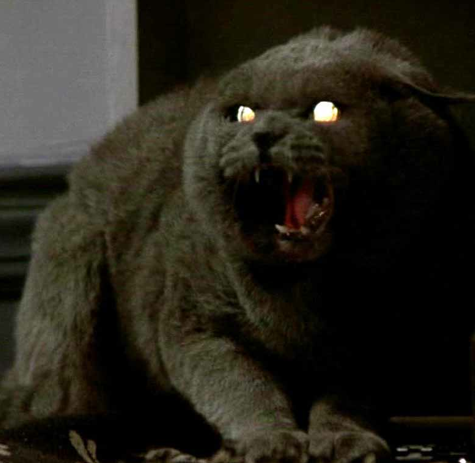 You’ve rewritten me 14 times. You think I’m going to leave without a fight? Hssssssss.
You’ve rewritten me 14 times. You think I’m going to leave without a fight? Hssssssss.Since we aren’t being honest about why the book isn’t working, we aren’t doing the hard work that would make the story publishable and we end up making a bad mess even worse.
In the end, be truthful. Are your “flowers” part of a garden or covering a grave? We put our craftiest work into buttressing our errors, so I would highly recommend taking a critical look at the favorite parts of your manuscript and then get real honest about why they’re there. Make the hard decisions, then kill them dead and bury your pets little darlings for real.
So what do you do with your little darlings? What’s been your experience? Do you have any tips, tools or tactics to help us dispose of the bodies? If you need help looking at your own plot with honest eyes, I have never met a plot I couldn’t fix and am an expert at assisted suicide for Little Darlings, so email me at kristen at wana intl dot com if you need help. I would also strongly recommend my Hooked—Your First Five Pages class below because you get me shredding through your novel’s intro. I can spot every problem in a novel in 20 pages or less. So save some time and get my help. There is no shame in needing outside eyes.
I LOVE hearing from you guys!
****The site is new, and I am sorry you have to enter your information all over again to comment, but I am still working out the kinks. Also your comment won’t appear until I approve it, so don’t fret if it doesn’t appear right away.
Also know I love suggestions! After almost 1,100 blog posts? I dig inspiration. So what would you like me to blog about?
Talk to me!
And to prove it and show my love, for the month of MARCH, everyone who leaves a comment I will put your name in a hat. If you comment and link back to my blog on your blog, you get your name in the hat twice. What do you win? The unvarnished truth from yours truly.
I will pick a winner once a month and it will be a critique of the first 20 pages of your novel, or your query letter, or your synopsis (5 pages or less).
February’s winner of the 20 page critique is Dominic Scezki. Congratulations! Please send your 5000 word WORD document (12 point, Times New Roman, one-inch borders, double-spaced) to kristen at wana intl.com.
SIGN UP NOW FOR UPCOMING CLASSES!!!
Remember that ALL CLASSES come with a FREE RECORDING so you can listen over and over. So even if you can’t make it in person? No excuses! All you need is an internet connection!
Individual Classes with MOI!
Blogging for Authors $50 March 30th, 2017
Pitch Perfect—How to Write a Query Letter and Synopsis that SELLS! $45 April 13th, 2017
Hooking the Reader—Your First Five Pages $40 March 18th, 2017
For those who need help building a platform and keeping it SIMPLE, pick up a copy of my latest social media/branding book Rise of the Machines—Human Authors in a Digital World on
March 13, 2017
The Engine of Fiction—Meet the Antagonist
One of the major issues with first-time novels is that the young writer fails to understand what a novel really is. All great stories are about one thing and one thing only—PROBLEMS. More specifically? Every good story has one core problem in need of being resolved. Granted, there will be many other problems along the way, but they are the setbacks and are all related to solving the core problem.
The trouble is that many of us got our “author training” in school, which really is no training at all. That purple prose that scored us an A on our college short story won’t get us far in the world of commercial storytelling. Additionally, pretty prose might be fine for keeping a five page or ten page short story interesting, but it falls apart under a body as weighty as a novel.
The new writer often senses this, so will work in navel-gazing and inner demons and then random bits of stuff going wrong and, instead of a well-structured story where tension and drama flow organically? We end up with melodrama.
Our “novel” then devolves into Days of Our Lives where nothing is really happening. Conflict is manufactured instead of inherent. “Bad stuff” is happening because the writer needs it to, not because “bad stuff” was inevitable.
How do we fix this?
Antagonists
The antagonist is a highly confusing topic. Hell, it confused me for years which is why I came up with my own term, which we will discuss today. Remember we said every story must have a core story problem?
That core story problem is created by the antagonist.
Conflict is the core ingredient to fiction, even literary fiction. Conflict in any novel can have many faces and often you will hear this referred to as the antagonist. The antagonist is absolutely essential for fiction. He/she/it is the engine of your story. No engine, and no forward momentum.
Like cars, plots need momentum or they are dead. The antagonist provides the energy to move the story forward. Yet, the antagonist has many, many faces and that is what trips up most new writers.
Think of your antagonist like ice cream–infinite colors, flavors, and complexities. The antagonist is not always evil. Yes villains are always antagonists but antagonists are not always villains.
Villains are only a flavor of antagonist, much like chocolate is only one flavor of ice cream. And, even in chocolate, there are still limitless varieties. Guess what? Same with villains. We’ll talk about them later.
This series is to explore the many facets of the most important element in fiction. Today, we are going to begin with what I call the BBT–or Big Boss Troublemaker. Why? Because the term antagonist confused the hell out of me for years, so I simplified things.
No BBT and you have no story. The BBT is not always bad or evil. The BBT simply creates the core story problem in need of being resolved.
Your opposition is the most important ingredient for a great story readers will love.
The Big Boss Troublemaker is whoever or whatever causes the protagonist’s world to turn upside down. The BBT creates the core story problem. The BBT is also who or what must be present at the Big Boss Battle (Act Three).
The lead up to the show-down with the BBT is responsible for creating our story tension. Will the protagonist evolve and triumph, or will he fail?
In commercial fiction, it is generally easier to spot the BBT.
No Sauron and no need for the Hobbits to leave the Shire.
No Darth Vader, no reason for Luke to leave Tatooine.
No Buffalo Bill, and Agent Starling is left doing paperwork.
This might seem simple enough, but time after time I get new manuscripts where there is no core story because there is no BBT. I get fantasy or science fiction manuscripts with a lot of fancy world-building and magic and bad stuff happening, but no core party responsible for a singular problem….so it all just fizzles.
Even in more literary works there is also a BBT and that BBT must have a face despite all we heard about man versus man, man versus religion, man versus nature, man versus society, etc. in school.
When the BBT is not corporeal? This is when things get tricky. Humans don’t do so great with existentialism, which is why we then need the proxy.
Let’s explore these.
Man Against Society
Whatever larger idea your protagonist is battling, that idea will need a manifestation. For instance, in The Hunger Games trilogy, “the system” is represented by Snow. The story is not over until Snow is defeated and his defeat marks the system’s defeat.
In The Help, the BBT is racism, but it is manifested in the white socialites who mistreat the maids (I.e. Hilly Holbrook). “Racism” is defeated when the socialites are defeated.
Man Against Nature
Some new writers take this as man fighting bad weather, but really? Who wants to read about bad weather for 300 pages? Often these stories are not about the weather at all, but rather what the weather reveals in people.
For instance, In The Perfect Storm, was the storm really the BBT? Or was it merely the impetus that brought forth the real BBT…pride which was manifested in the captain, Billy Tyne?
The fishermen are suffering. They are on the verge of losing homes and marriages because of their dire economic situation. The captain decides to do one final fishing voyage even though it is the most dangerous time of the year. When the fisherman go out, they land the catch of a lifetime, but the refrigeration system breaks.
They are faced with a choice. Let the fish rot and then it was all for nothing. Or they can risk everything and take on the perfect storm (pride).
In my POV, the story is never man against nature, it is man against himself and nature is simply the catalyst.
Man Against Himself
No one wants to read a book of nonstop navel gazing. Thus if your character’s worst enemy is himself/herself? You need a proxy. The BBT will represent the particular aspect you are seeking to destroy and then the BBT will have a face.
For instance, in the movie 28 Days, the BBT is alcoholism, but it is represented in the proxy Jasper, the hard-partying boyfriend who fuels and normalizes Gwen’s addiction.
Gwen is her own worst enemy. She must defeat her own alcoholism. But this will be manifested when she can finally see herself as an addict and walk away from the life of addiction (where Jasper is its representative).
We could go on forever on this topic, but we won’t. Just pay attention to your favorite stories and see if you can pinpoint the BBT and then notice how it is always the protagonist-turned-hero who will face off with him/her/it at the end.
Some Pretty Hard and Fast BBT Rules—Break these Rules at Your Own Risk
Rule #1—BBT (or a proxy of the BBT) MUST be introduced in Act I. No leading us on for 50 pages before we get an introduction. BBT is responsible for Inciting Incident.
Rule #2—In ROMANCE, the love interest cannot be the BBT. Romance has rules and this is a big one. Now, in romance, the love interest will take on the role of antagonist in scenes, but they cannot be the BBT. Why? Because the BBT must be defeated in the Big Boss Battle, and utter defeat isn’t exactly grounds for a lasting relationship. Romance is all about the HEA (happily ever after)
Feel free to break this rule, but I will warn you that when the BBT is the love interest, it is no longer a romance. It becomes Women’s Fiction 

